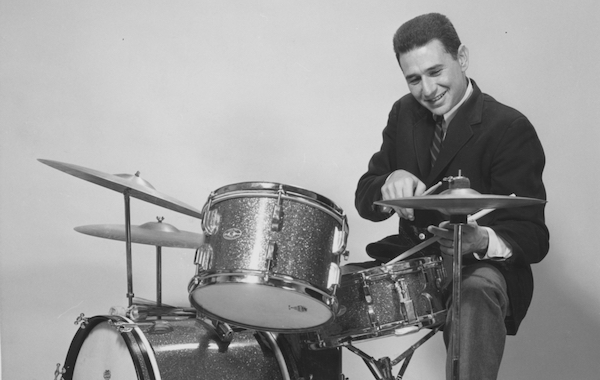Apr 2, 2024 12:59 PM
Saxophonist, Sonic Explorer Casey Benjamin Dies at 45
Casey Benjamin, the alto saxophonist, vocalist, keyboardist and producer who stamped his distinctive sounds on the…

Drummer Shelly Manne’s work as a leader and sideperson exhibits his refusal to be pigeonholed.
(Photo: Dave Pell/DownBeat Archives)A case can be made that no other drummer of his era had, in today’s parlance, a stronger “brand” than Shelly Manne. A consummate studio artist, he resisted the pyrotechnics of Buddy Rich, Max Roach and Elvin Jones, but when his name was attached to a project, listeners could bank on its inventiveness, quality and widespread appeal.
The head spins when reading through the discography of this astonishingly prolific artist, who was born in New York in 1920 and died in Los Angeles 64 years later. Manne played in the bands of Benny Goodman, Stan Kenton and Dizzy Gillespie, and he was a key figure in the umbrella movement known as West Coast jazz, leading various groups.
Iconic recordings on which he played drums include Coleman Hawkins’ “The Man I Love” and Sonny Rollins’ Way Out West. He also recorded a series of trio albums with pianist André Previn, and wrote and recorded music for TV and films. Albums by Ella Fitzgerald, Art Pepper, Nancy Wilson and Tom Waits all benefited from Manne’s artistry.
For all his achievements—including his stewardship of a club he dubbed Shelly’s Manne-Hole in Hollywood—Manne still might be underappreciated today. But many of his leader albums—including The Three & The Two, a pairing of trio and duo performances from the early 1950s, and 2-3-4, a 1962 album featuring Hawkins—are keenly appreciated by modern players.
And though The New Grove Dictionary of Jazz figures that Manne was “opposed to ostentatious displays of technical skill,” his playing still can inspire awe today.
“He had a really amazing groove and cymbal beat,” said drummer Matt Wilson. “But it was the way he integrated his playing with the ensemble, making it part of the fabric of the song, that really made him special. And his imagination was boundless.
“I was recently listening to a Vic Damone recording of ‘Am I Blue,’ not knowing who the drummer was. He was playing in an orchestrated fashion with brushes and hands. And then I instantly knew it was Shelly, because who else could have created this beautiful moment by gently hitting the cymbal with his thumb?”
Though Manne spent most of his career in the middle lane of jazz, he always kept his ears open to possible new directions. His 1956 LP My Fair Lady is regarded as the first instrumental jazz album devoted to songs from a single Broadway show, and it was voted the top jazz LP in DownBeat’s Disc Jockey Poll.
Other mainstream artists wanted nothing to do with the “new” jazz, but Manne embraced it. He’s the drummer, lest we forget, on Ornette Coleman’s 1959 LP Tomorrow Is The Question!
“He refused to be pigeonholed, to be associated only with certain things,” Wilson said. “In remaining open, he had the same spirit as Coleman Hawkins.”
One of Manne’s boldest achievements was the unjustly obscure 1963 album My Son The Jazz Drummer!—Modern Jazz Versions Of Favorite Jewish And Israeli Songs, featuring trumpeter Shorty Rogers, saxophonist Teddy Edwards and other luminaries. Reissued on CD in 2004 under the title Steps To The Desert, the program anticipated the Jewish music adaptations of such modern artists as John Zorn, Uri Caine, Don Byron, Frank London and David Krakauer.
Manne pushed in yet another direction with his “vaguely African music” (as Steely Dan’s Walter Becker described it to Guitar Magazine) for the TV show Daktari, which ran from 1966 to 1969.
“Many years before the coining of the term ‘world music,’ Shelly was hip to its possibilities in jazz,” said pianist Bill Mays, whose 1983 album, Tha’s Delights, featured the drummer. “He played all kinds of percussion instruments including berimbau [a Brazilian musical bow]. It was really hip then and, like Shelly, it’s just as hip now.” DB

Benjamin possessed a fluid, round sound on the alto saxophone, and he was often most recognizable by the layers of electronic effects that he put onto the instrument.
Apr 2, 2024 12:59 PM
Casey Benjamin, the alto saxophonist, vocalist, keyboardist and producer who stamped his distinctive sounds on the…

“He’s constructing intelligent musical sentences that connect seamlessly, which is the most important part of linear playing,” Charles McPherson said of alto saxophonist Sonny Red.
Feb 27, 2024 1:40 PM
“I might not have felt this way 30 to 40 years ago, but I’ve reached a point where I can hear value in what people…

Albert “Tootie” Heath (1935–2024) followed in the tradition of drummer Kenny Clarke, his idol.
Apr 5, 2024 10:28 AM
Albert “Tootie” Heath, a drummer of impeccable taste and time who was the youngest of three jazz-legend brothers…

“Both of us are quite grounded in the craft, the tradition and the harmonic sense,” Rosenwinkel said of his experience playing with Allen. “Yet I felt we shared something mystical as well.”
Mar 12, 2024 11:42 AM
“There are a few musicians you hear where, as somebody once said, the molecules in the room change. Geri was one of…

Henry Threadgill performs with Zooid at Big Ears in Knoxville, Tennessee.
Apr 9, 2024 11:30 AM
Big Ears, the annual four-day music celebration that first took place in 2009 in Knoxville, Tennessee, could well be…